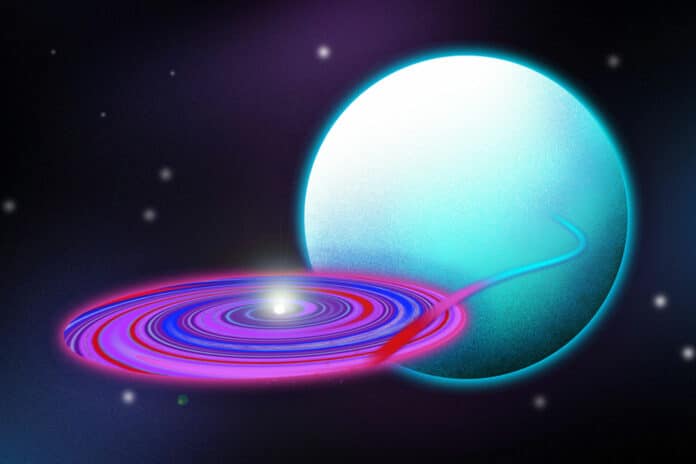Black holes and neutron stars frequently experience outflows from the accretion of matter, which can significantly impact the compact object’s surroundings. To understand the launching mechanism and overall wind energy budget, it is essential to understand the global three-dimensional wind structure. X-ray absorption line spectroscopy is a key tool for studying these winds because it allows us to probe their properties along a single sightline.
MIT astronomers have now seen a wider swath of winds in the system of Hercules X-1, where a neutron star is removing material from a sun-like star. The accretion disc of this neutron star is unusual in that it wobbles or “processes” while rotating. Astronomers could collect several views of the revolving disc and produce a two-dimensional map of its winds by taking advantage of this jiggling.
The new map shows the wind’s vertical shape and structure and its velocity, which is on the lower end of what accretion discs can spin up at approximately a million miles per hour or hundreds of kilometers per second.
The team’s mapping method could help astronomers understand how disc winds affect the birth and evolution of star systems, and perhaps entire galaxies, if they can find more wobbling systems in the future.
It is possible to infer information about a wind’s origins from its structure, but it has proven challenging to determine the shape and size of disc winds. The majority of binaries create accretion discs that are generally uniform in shape, resembling thin gas donuts that rotate in a single plane.
Astronomers studying these discs from distant satellites or telescopes can only see the impact of disc winds relative to their rotating disc within a set and limited range. Therefore, any wind that astronomers can observe is only a tiny fragment of its whole structure.
Peter Kosec, a postdoc at MIT’s Kavli Institute for Astrophysics and Space Research, said, “We can only probe the wind properties at a single point, and we’re completely blind to everything around that point.”
Scientists discovered in 2020 that one binary system might provide a more comprehensive perspective of disc winds. In contrast to most other known X-ray binaries, Hercules X-1 has a distorted accretion disc that wobbles as it revolves around the system’s primary neutron star.
Kosec said, “The disk is really wobbling over time every 35 days, and the winds are originating somewhere in the disk and crossing our line of sight at different heights above the disk with time. That’s a unique property of this system which allows us to understand its vertical wind properties better.”
In the latest research, the XMM Newton and Chandra X-ray telescopes of the European Space Agency and NASA were used to observe Hercules X-1.
Kosec said, “We measure an X-ray spectrum, which means the number of X-ray photons that arrive at our detectors versus their energy. We measure the absorption lines or the lack of X-ray light at particular energies. From the ratio of how strong the different lines are, we can determine the temperature, velocity, and the amount of plasma within the disk wind.”
Astronomers could observe the warped disc of Hercules X-1 as it wobbled and rotated, much like how a warped record appears to oscillate when viewed from the edge-on. As a result, rather than at a single, set height above a uniformly rotating disk, scientists could detect traces of disc winds at varying sizes about the disc.
The researchers could scan parameters like the temperature and density of winds at different heights with respect to its disc and create a two-dimensional map of the wind’s vertical structure by analyzing X-ray emissions and the absorption lines as the disc wobbled and rotated over time.
Kosec said, “What we see is that the wind rises from the disk at an angle of about 12 degrees with respect to the disk as it expands in space. It’s also getting colder and more clumpy and weaker at greater heights above the disk.”
The team plans to compare their observations with theoretical simulations of various wind-launching mechanisms to see which could best explain the wind’s origins. Further out, they hope to discover more warped and wobbling systems and map their disk wind structures. Then, scientists could have a broader view of disk winds and how such outflows influence their surroundings — particularly at much larger scales.
Journal Reference:
- Kosec, P., Kara, E., Fabian, A.C. et al. Vertical wind structure in an X-ray binary revealed by a precessing accretion disk. Nat Astron (2023). DOI: 10.1038/s41550-023-01929-7
